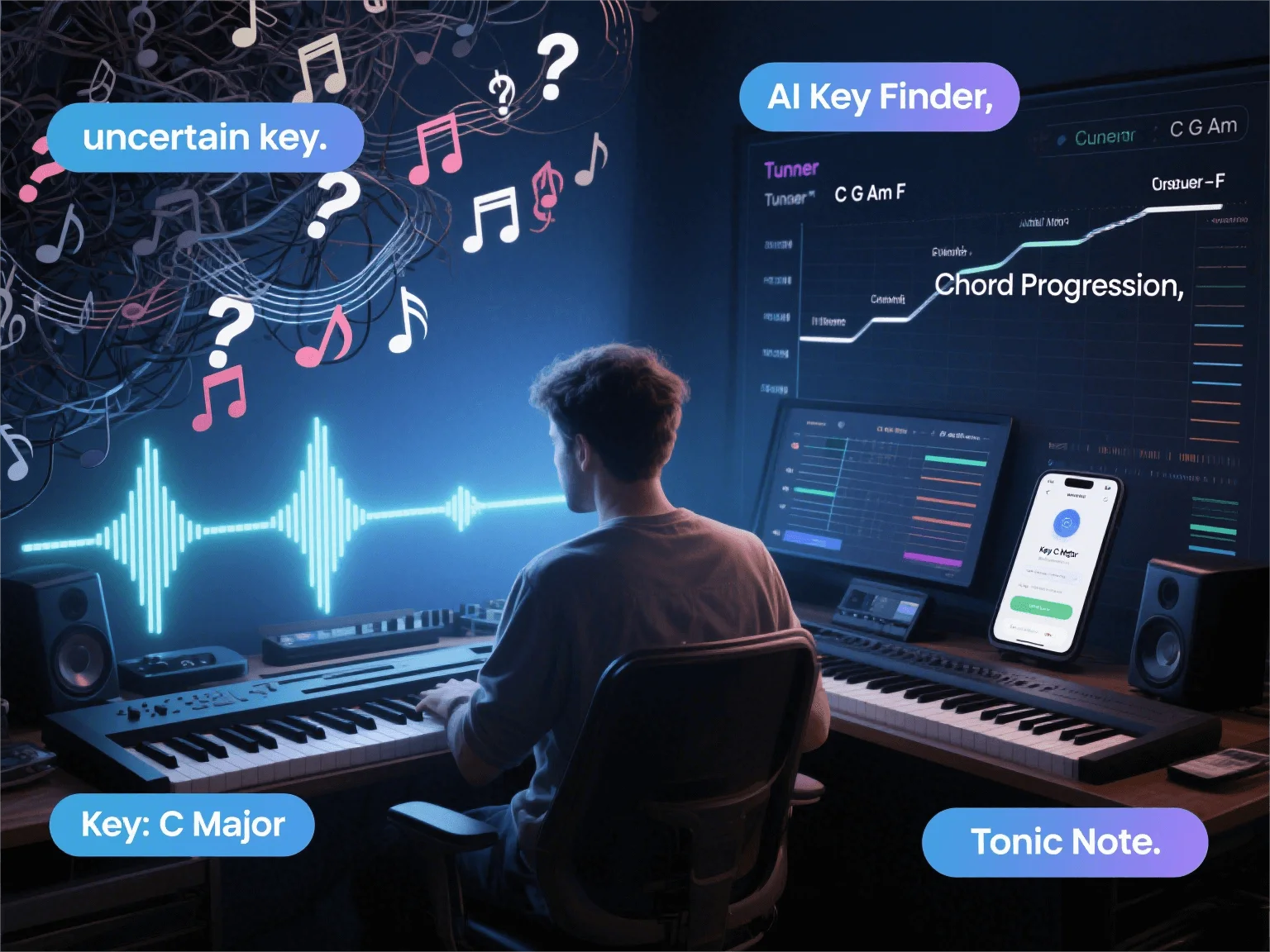
如何找出歌曲的调(5种简单方法)
更新时间: 2025-08-12 08:55:01
老实说。你有一个超赞的采样,一首想混音的歌曲,或者一段旋律在你脑海中挥之不去,而你现在就想知道它的调。
但找出歌曲的调感觉就像一个巨大的创意障碍。它会彻底打断你的创作流,让一个令人兴奋的制作过程变成在钢琴上随意弹奏的令人沮丧的猜谜游戏。
好消息是:它不必那么难。
在本指南中,我们将向你展示五种实用的方法来找到歌曲的调,从即时AI工具到能锻炼你乐感的传统技术。无论你需要在5秒内得到答案,还是想像专业人士一样训练,你都可以在这里找到解决方案。
快速总结:找到歌曲调的5种最佳方法
即时结果:使用像Vozart.ai这样的AI调性查找器。(最快&最简单)
训练你的耳朵:听主音,分析和弦,并找出常见的和弦进行。(培养技能)
使用乐器:使用钢琴或吉他通过耳朵找到“主音”。
使用手机:将根音哼唱到免费调音器应用中。
对于复杂歌曲:让AI为你处理复杂的调性变化和模糊的和声。
为什么了解调性会让你成为更好的制作人
现在你已经知道找到它的最快方法了,让我们快速回顾一下为什么调性如此重要。了解歌曲的调性不仅仅是乐理——它是一种创造性的超能力。
- 构建完美的和声:当你了解声部、合成器或采样在音乐上如何和谐共存时,分层就变得轻而易举。
- 创作律动感十足的贝斯线:即刻知道将支撑你的歌曲并使其听起来专业的根音。
- 自信地混音:确保你的人声清唱和器乐处于同一调性,以实现无缝、专业的混音。
- 高效协作:与其他音乐人和制作人说同一种语言。“这首歌是C小调”是一个普遍的起点。
简而言之,了解调性赋予你掌控权并释放你的创作自由。
方法1:使用AI调性查找器即时获得结果(最快的方法)
在现代音乐制作中,你的工作流程需要快速流畅。既然可以知道,为什么要猜测呢?当你需要即时准确的答案时,AI调性查找器是终极工具。
工作原理:简单的3步指南
使用Vozart.ai非常简单。你可以在不到一分钟的时间内,将一个未知的音频文件转化为完整的和声分析。
- 上传你的歌曲:将任何音频文件(MP3、WAV等)直接拖放到Vozart.ai中。[图片占位符:插入Vozart.ai上传界面的截图]
- 让AI完成工作:我们的算法分析音频,识别主音、音阶和和弦变化。
- 获取结果:即时查看歌曲的调性、BPM以及完整、可播放的和弦图。[图片占位符:插入Vozart.ai结果页面的截图]
方法2:通过寻找主音(“主音”)来训练你的耳朵
如果你想培养自己的音乐直觉,学会通过耳朵识别调性是一项宝贵的技能。第一步是找到主音。
主音是音乐感觉解决和休止的音。它是调的“主音”。跟着歌曲哼唱,试着找到那个感觉像是终点的音。通常,歌曲会以这个音开始和结束。如果这个音是C,那么这首歌很可能就是C调。
方法3:分析第一个和最后一个和弦
歌曲的第一个和最后一个和弦是重要的线索。大多数歌曲都以主和弦(“I”和弦)开始和结束。一首C大调的歌曲很可能以C大调和弦开始和结束,这会给它带来一种稳定感和解决感。如果你能在钢琴或吉他上识别出这两个和弦,你很可能就找到了你的调。
方法4:解读和弦进行
和弦进行是重复的模式,强烈地指向调。如果你能识别和弦,你通常就能推断出调。寻找常见的模式:
- I-IV-V(例如,C-F-G):流行、摇滚和布鲁斯的基础。如果你听到这个,你几乎可以肯定是在“I”和弦的调性(C大调)。
- I-V-vi-IV(例如,C-G-Am-F):无数热门歌曲中使用的“四和弦流行进行”。
发现这些常见模式是快速确定调性的一种方法。
方法5:使用参考乐器或应用程序
你不需要完美的音高来找到调——你只需要一个参照点。
- 使用乐器:在歌曲播放时在钢琴或吉他上弹奏音符,直到找到一个听起来像“主音”的音(主音)。
- 使用调音器应用程序:没有乐器?没问题。手机上的简单吉他调音器应用程序也能同样有效。将你认为的主音哼唱到应用程序中,它会告诉你这个音是什么。
常见挑战(以及如何克服它们)
如果一首歌没有明确的调性怎么办?(调性模糊)
有些歌曲很棘手!它们可能使用调式或改变调(转调)。在这些情况下,请关注主要部分,如副歌。它在哪里感觉最稳定?即使其他部分发生变化,副歌通常也掌握着真正的调。
不要被复杂的和弦误导
有时一个不完全在调性内的和弦会出现,以制造张力。不要让它迷惑你。始终倾听音乐“想去哪里”,这通常是回到主和弦。
结论
你现在已经有了一个完整的路线图,可以找出任何歌曲的调。你可以通过强大的工具走快速通道,也可以选择通过训练耳朵走风景优美的路线。
最好的制作人两者兼而有之。他们用耳朵快速获得灵感,并使用AI工具来确认这些灵感,分析复杂的和声,并极大地提高他们的工作效率。
准备好释放你的创作流并制作出音调完美、和谐动听的音乐了吗?
